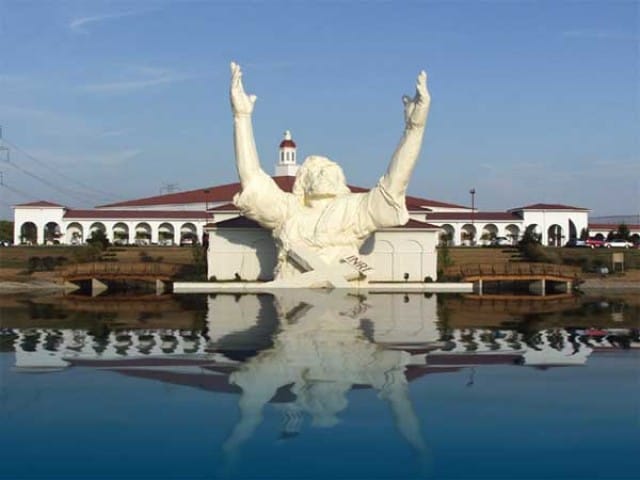"Hug Me Jesus" Resurrected, But What Does it Mean?
In Monroe, Ohio at Solid Rock Church there was a giant statue of Jesus with arms wide open toward Interstate-75. That was until 2010, in what some could consider divine comedy, the statue was struck by lighting and promptly burst into flames, leaving nothing but it's skeletal remains behind. Althoug

In Monroe, Ohio at Solid Rock Church there was a giant statue of Jesus with arms wide open toward Interstate-75. That was until 2010, in what some could consider divine comedy, the statue was struck by lighting and promptly burst into flames, leaving nothing but it’s skeletal remains behind. Although safely situated in New York, and San Francisco now, I can look back and laugh at the absurdity of these giant sculptures, there is a real seriousness around them. As the election debates increasingly circle around issues of religious dogma, mostly surrounding women’s and queer rights, these statues are not to be ignored or laughed off. Living near a 100-foot cross myself was not exactly perceived as a symbol of warmth and embracement, but rather a missionary imposition. To my small circle of artsy friends, these statues felt like demands for us to change our beliefs and to conform, with an underlying threat of eternal damnation. These are powerful symbols that are being thrust onto a public with different beliefs and traditions.
… the point has become conversion and subsequent salvation, certainly a type of theology I cannot get behind, and one that makes me feel very uncomfortable.
Now, two years later, the church has re-installed another large statue of Jesus to once again become a beacon of their religion, a giant icon planting itself into the highway goers’ landscape. Having grown up only an hour drive from this statue, I have friends who live nearby and I have even driven by it several times on my way to Cincinnati, Ohio. I wish I could say passing the statue felt foreign, but drivers passing through my own hometown in Richmond, Indiana on Interstate-70 will see a 100-foot tall white cross marking, amongst other things, a rehabilitation center for youths with drug problems or youths who are ‘struggling’ with homosexuality.
It feels largely distant to me now, but the majority of their surrounding communities find these statues to be important for their personal spirituality and uplifting symbols for the community. A friend who lives nearby the Jesus statue told me over Facebook, “everyone else around here is real pumped about it, [the reinstallation of the statue] they were super depressed when he burned down. he [the Jesus statue] was like a community icon for the greater dayton/cinci area.” As public art, the Jesus statue is actually representative of the majority of the area’s population. The statue had become a symbol of faith to many and representation of what the edge of the Bible Belt had to offer.

Undoubtedly I am not the average kid from Richmond, Indiana or Monroe, Ohio, but I was certainly not unique. Although mostly Christian, there are Jewish, Muslims, Islamic, atheists, and more in the area; I wonder what they think of this type of public art? Important to remember is that these monuments to Christianity are often found along highways, and those driving by are most likely more diverse in their beliefs and culture than the local church goers are. If these statues were serving only the local community, they would be nearer the center of town, not so large, or not facing the highway. Instead, the point has become conversion and subsequent salvation, certainly a type of theology I cannot get behind, and one that makes me feel very uncomfortable.
Dismissing critics that defamed the work and spread rumors that the fire in 2010 was the work of God, co-pastor of Solid Rock Church Darlene Bishop spoke up right after the fire, “I think he (Jesus) couldn’t have gotten this much advertising if we had paid a billion dollars.” Which more thoroughly reveals much of the motivation behind the statue. This is an advertisement, striving to ‘sell’ Christianity to its onlookers. It’s propaganda, with a simple message that is forcing a singular belief onto the onlooker. Not only does that type of conversation repulse me, it makes for incredibly boring art.




